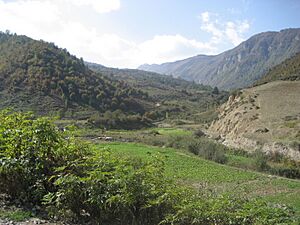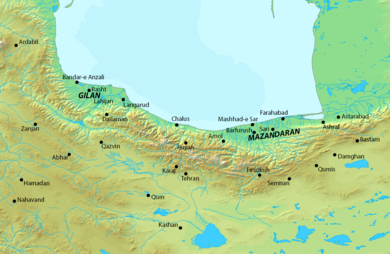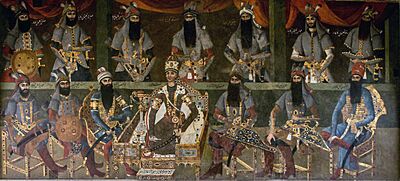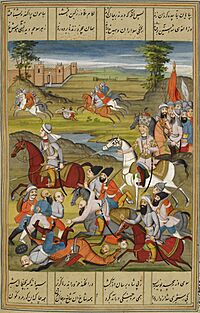Agha Mohammad Khan Qajar facts for kids
Quick facts for kids Agha Mohammad Khan Qajar |
|||||||||
|---|---|---|---|---|---|---|---|---|---|
| Shah | |||||||||

Portrait of Agha Mohammad Khan Qajar, 1820.
|
|||||||||
| Shah of Iran | |||||||||
| Reign | 1789 – 17 June 1797 | ||||||||
| Coronation | March 1796 | ||||||||
| Predecessor | Lotf Ali Khan | ||||||||
| Successor | Fath-Ali Shah Qajar | ||||||||
| Vizier | Hajji Ebrahim Shirazi | ||||||||
| Born | 14 March 1742 Astarabad, Afsharid Iran |
||||||||
| Died | 17 June 1797 (aged 55) Shusha, Qajar Iran |
||||||||
| Burial | Imam Ali Mosque | ||||||||
| Spouse | Maryam Khanom | ||||||||
| Issue | None | ||||||||
|
|||||||||
| Dynasty | Qajar dynasty | ||||||||
| Father | Mohammad Hasan Khan Qajar | ||||||||
| Mother | Jeeran Khanum | ||||||||
| Religion | Twelver Shia Islam | ||||||||
| Tughra |  |
||||||||
Agha Mohammad Khan Qajar (born March 14, 1742 – died June 17, 1797) was the founder of the Qajar dynasty in Iran. He ruled as Shah from 1789 to 1797. He became king in 1789 but was officially crowned in March 1796. He took power after defeating Lotf Ali Khan of the Zand dynasty in 1794. Agha Mohammad Khan had no children. He was killed in 1797 and his nephew, Fath-Ali Shah Qajar, became the next ruler.
Agha Mohammad Khan's rule is known for bringing Iran back together as a strong, united country. He also moved the capital city to Tehran, which is still the capital today. He was known for being a very strict and sometimes harsh leader, especially during his campaigns in Georgia and Kerman. However, he was also seen as a smart and skilled military and political leader.
Contents
Early Life and Challenges (1742–1779)
Family Background and Youth
Agha Mohammad Khan was born in Astarabad around 1742. He belonged to the Quwanlu branch of the Qajar tribe. The Qajars were a group of Turkoman tribes that had been important in Iran for centuries. Agha Mohammad Khan was the oldest son of Mohammad Hasan Khan Qajar, who was the leader of the Quwanlu clan. His grandfather, Fath-Ali Khan Qajar, was an important noble who was executed by Shah Tahmasp II.
After Nader Shah died in 1747, Iran's government became weak. This gave Mohammad Hasan a chance to take control of Astarabad. Nader Shah's nephew, Adel Shah, tried to capture Mohammad Hasan. He failed but captured Agha Mohammad Khan. Adel Shah decided not to kill Agha Mohammad Khan and later set him free.
Loss of His Father
For the next ten years, there was much fighting in Iran. Mohammad Hasan fought against other leaders for control. However, he was defeated in 1759 by an army from the Zand dynasty. He was then killed by an old rival. Agha Mohammad Khan could not have children, so his brother Hossein Qoli Khan became the new leader of their clan. Soon after, Astarabad came under the control of Karim Khan of the Zand dynasty. Agha Mohammad Khan and his brother Hossein Qoli Khan had to flee.
Agha Mohammad Khan tried to take back Astarabad but failed. He was eventually captured and sent as a hostage to Tehran, which was ruled by Karim Khan. His brother Hossein Qoli Khan was also captured and sent to Karim Khan.
Life at the Zand Court

During his time with Karim Khan, Agha Mohammad Khan was treated well. Karim Khan even asked for his advice on important matters. He saw Agha Mohammad Khan as a wise counselor. Agha Mohammad Khan's brothers were also allowed to live in different cities.
In 1769, Karim Khan made Hossein Qoli Khan the governor of Damghan. Hossein Qoli Khan started fighting with other tribes to get revenge for his father's death. He was killed around 1777. On March 1, 1779, Agha Mohammad Khan learned that Karim Khan had died. This was his chance to act.
Taking Control of Iran (1779–1789)
Conquering Mazandaran and Gilan
After Karim Khan's death, Agha Mohammad Khan quickly gathered his loyal followers and went to Tehran. He made peace with other important leaders there. Then he traveled to the Mazandaran Province. His first goal was to become the main leader among his own Qajar brothers. He defeated his brothers Reza Qoli and Morteza Qoli, taking control of Mazandaran.
Morteza Qoli fled to Astarabad and made it a strong base. Agha Mohammad Khan couldn't easily attack him because it might break his peace with other tribes. Meanwhile, a Zand army tried to invade Mazandaran, but Agha Mohammad Khan's brother, Jafar Qoli Khan, pushed them back. Agha Mohammad Khan was now in a strong position in Babol, the capital of Mazandaran.
Later, Agha Mohammad Khan had more conflicts with his brothers. He eventually defeated Reza Qoli several times and made peace with him. He also made the ruler of Gilan, Hedayat-Allah Khan, accept his authority. He then gave land to his brother Ali Qoli for his help in conquering cities.
Early Conflicts and Expansion
In 1781, the Russian Empire wanted to build a trading post in Iran. They sent a group to the coast of Gorgan. Agha Mohammad Khan refused their request. The Russians ignored him and set up a temporary settlement on Ashurada island. Since Agha Mohammad Khan had no ships, he couldn't take the island back. Instead, he tricked the Russian leader and some of his men into a banquet in Astarabad. He held them captive until the Russians agreed to leave the island.
A year later, Agha Mohammad Khan invaded Gilan because its ruler had sided with the Zand dynasty. Agha Mohammad Khan raided Gilan's capital, Rasht, and took its wealth. He then sent his brother Jafar Qoli Khan to conquer northern Persian Iraq. Jafar Qoli Khan defeated a Zand army and took control of Qazvin and Zanjan. In the spring of 1783, Agha Mohammad Khan tried to capture Tehran, but a plague spread, forcing him to stop the attack.
Mazandaran Under Zand Control (Briefly)
In 1784, the Zand ruler, Ali-Morad Khan, sent a large army to Mazandaran to defeat the Qajars. Many people in Mazandaran quickly surrendered to the Zands. Agha Mohammad Khan and some supporters fled to Astarabad and fortified the city. Morteza Qoli, his brother, switched sides and joined the Zands.
Ali-Morad Khan sent an army to besiege Astarabad. Agha Mohammad Khan had prepared for a siege and his troops attacked the countryside to limit the Zand army's supplies. This made the Zand army's situation difficult. Agha Mohammad Khan then left the city to attack them. The Zand commander fled but was captured and killed. Agha Mohammad Khan then marched into Mazandaran and defeated a Zand force. The Zands were forced to retreat.
First War with Jafar Khan Zand
Ali-Morad Khan died in February 1785. When Agha Mohammad Khan heard this, he went to Tehran to capture it. The people of Tehran refused to open the gates, saying they would only open them for the true king, who they believed was Jafar Khan Zand. So, Agha Mohammad Khan had to defeat Jafar Khan. He quickly marched towards Isfahan. Jafar Khan sent troops to stop him, but they retreated. Agha Mohammad Khan defeated another Zand army near Kashan. Jafar Khan then fled to Shiraz. Agha Mohammad Khan arrived in Isfahan in May, where his troops looted the city.
In the summer of 1785, Agha Mohammad Khan used Isfahan as his base. He brought the Bakhtiari chieftains under his control. He then went to Tehran, which finally surrendered to him. His men also captured Hamadan, forcing many local leaders to accept Qajar rule. On March 12, 1786, Agha Mohammad Khan made Tehran his capital. At this time, he saw himself as the king of Iran, but he did not yet use the title "shah."
Later, while Agha Mohammad Khan was away, Jafar Khan quickly recaptured Isfahan. Agha Mohammad Khan quickly moved back towards Isfahan, which made Jafar Khan retreat to Shiraz again. Agha Mohammad Khan then appointed Jafar Qoli Khan as the city's governor.
Second Invasion of Gilan
Agha Mohammad Khan then focused on Gilan again. Its ruler, Hedayat-Allah Khan, had returned to the province. Agha Mohammad Khan and his men easily entered Gilan. The Russian consul in Gilan even helped Agha Mohammad Khan by providing weapons. Hedayat-Allah tried to flee but was captured and killed by a local ruler. Gilan was now fully under Qajar rule. Agha Mohammad Khan also gained Hedayat-Allah's treasure, which was very valuable.
Second War with Jafar Khan Zand and Crowning
Later, a local ruler named Amir Mohammad Khan invaded Qajar territory and marched towards Isfahan. Jafar Qoli Khan, the governor of Isfahan, defeated him. Agha Mohammad Khan then went south again. He made another local ruler, Taqi Khan, accept Qajar rule. He also punished some Qashqai tribes. Agha Mohammad Khan then approached Shiraz, hoping to draw Jafar Khan out of the strongly fortified city. But Jafar Khan stayed inside. Agha Mohammad Khan returned to Isfahan, appointed his brother Ali Qoli as governor, and then left for Tehran.
With Agha Mohammad Khan in the north, Jafar Khan again raised an army and attacked Isfahan. Ali Qoli retreated. Jafar Khan occupied Isfahan in October. Agha Mohammad Khan quickly marched towards Isfahan, causing Jafar Khan to retreat to Shiraz again. Agha Mohammad Khan returned to Tehran instead of attacking Shiraz. Jafar Khan was killed on January 23, 1789. This led to a civil war among Zand princes. In May, Jafar Khan's son, Lotf Ali Khan, won this civil war.
It was during this time that Agha Mohammad Khan was formally made king (though not yet crowned). He named his nephew Baba Khan (who later became Fath-Ali Shah Qajar) as his heir. So, 1789 is considered the start of his rule.
Agha Mohammad Khan's Reign (1789–1797)
War with Lotf Ali Khan and Family Issues
First Attack on Shiraz and Family Disputes
With the Zand dynasty weakened, Agha Mohammad Khan saw a chance to capture Shiraz for good. He marched towards the city and was attacked by Lotf Ali Khan. A battle took place on June 25, 1789. Lotf Ali Khan retreated to Shiraz, and Agha Mohammad Khan besieged the city. The siege lasted until September 7. He then returned to Tehran.
In May 1790, Agha Mohammad Khan marched towards Shiraz again. The governor of Bihbahan accepted his authority. Lotf Ali Khan left Shiraz to stop Agha Mohammad Khan, but the Qajar ruler went to Qazvin to solve some problems there. Agha Mohammad Khan later had a disagreement with Jafar Qoli Khan, who thought he should be the next Qajar ruler. Agha Mohammad Khan had him executed. He believed this was necessary to prevent the kind of family disputes that had weakened the Zand dynasty.
Conquering Azerbaijan
While Lotf Ali Khan was busy in Kerman, Agha Mohammad Khan focused on Azerbaijan. He made Baba Khan the governor of Persian Iraq and marched into Azerbaijan in the spring of 1791. He forced several local leaders to accept Qajar rule. He then went to Ardabil and visited its important shrine. He ended all resistance in the region and appointed a noble named Hosayn Qoli Donboli as the governor of Khoy and Tabriz.
Conquest of Fars
While Agha Mohammad Khan was conquering Azerbaijan, Lotf Ali Khan used the chance to attack Isfahan. However, Hajji Ebrahim Shirazi, the popular governor of Shiraz, staged a takeover while Lotf Ali Khan was away. Hajji Ebrahim's brother, Mohammad-Hosayn Shirazi, who was Lotf Ali Khan's general, also rebelled with many troops. Lotf Ali Khan rushed back to Shiraz, but the people refused to open the gates. He went into the mountains to gather an army.
Hajji Ebrahim then asked Agha Mohammad Khan to become the ruler of Fars. Agha Mohammad Khan immediately agreed. When he arrived in Fars, he made Hajji Ebrahim the governor of the entire province. He also sent his men to take Lotf Ali Khan's family and the Zand family's possessions to Tehran. He ordered Baba Khan to set up a military base near Shiraz to help Hajji Ebrahim if needed.
Lotf Ali Khan defeated the men sent by Hajji Ebrahim and captured the stronghold of Kazerun. He then marched to the countryside near Shiraz, planning to starve the city. The Qajar army from the nearby base attacked Lotf Ali Khan's men. At first, the Qajars were winning, but Lotf Ali Khan joined the battle himself, and the Qajar army was defeated. When Agha Mohammad Khan heard this, he sent more soldiers to help Hajji Ebrahim.
Lotf Ali Khan allowed the reinforcements to reach Shiraz, hoping they would come out for an open battle. He was right. A battle soon took place west of Shiraz, where Lotf Ali Khan defeated the combined forces of Hajji Ebrahim and the Qajar reinforcements. This happened in late 1791 or early 1792.
The people of Shiraz faced great difficulties from the siege. Agha Mohammad Khan then raised a large army and marched into Fars. On June 5, 1792, Lotf Ali Khan made a bold night attack on Agha Mohammad Khan's camp near Persepolis. At first, it seemed Lotf Ali Khan had won. He let his men rest, but at dawn, he found that Agha Mohammad Khan was still there. Lotf Ali Khan then fled. Agha Mohammad Khan entered Shiraz on July 21, 1792. Before leaving Shiraz, he made Hajji Ebrahim the governor of Fars. He also had the body of Karim Khan Zand moved and reburied in Tehran.
Conquest of Kerman
Lotf Ali Khan fled to Khorasan and received help from a local chief. With this help, he returned in September and marched towards Yazd. He captured Abarkuh and other towns. The Qajar forces sent against him wasted time, allowing Lotf Ali Khan to capture more areas. He then marched on Darab but fled back to Khorasan when he heard of the Qajar army.
The Afghan chiefs of Bam invited Lotf Ali Khan to return and remove Qajar rule. With their help, Lotf Ali Khan returned to Kerman and captured the city on March 30. Agha Mohammad Khan Qajar quickly heard this and marched towards Kerman on May 14. The siege lasted four months and was very hard on Kerman's people. The city fell on October 24, and Lotf Ali Khan quickly fled to Bam. However, the chief of Bam handed Lotf Ali Khan over to the Qajars. Agha Mohammad Khan Qajar punished the people of Kerman very harshly. The city was severely damaged.
A year later, after the Battle of Krtsanisi brought eastern Georgia and other areas in the North Caucasus and South Caucasus back under Iranian control, he declared himself Shahanshah (King of Kings).
Reconquering Georgia and the Caucasus
Georgia had been under Iranian influence for centuries. For Agha Mohammad Khan, bringing Georgia back into the Iranian Empire was important. He saw it as part of Iran, just like other provinces. He believed it was his duty to bring back regions that had been lost after Nader Shah's death.
Agha Mohammad Khan demanded that the Georgian king, Heraclius II, end his treaty with Russia and accept Iranian rule again. The Ottoman Empire, Iran's rival, even recognized Iran's rights over Georgia. Heraclius II asked Russia for help, but he received none, leaving Georgia to face the Iranian threat alone. Heraclius II still refused Agha Mohammad Khan's demand.
In August 1795, Agha Mohammad Khan crossed the Aras river with a large army. He divided his forces. His main goal was Georgia. He sent Heraclius II a final warning, reminding him that Georgia had been part of Iran for a long time. He warned that if Heraclius II did not break ties with Russia, he would attack Georgia.
Heraclius II ignored the warning. Agha Mohammad Khan marched directly on Tbilisi, the capital of Georgia. His army attacked the Georgian positions. Despite brave resistance from the Georgians, the Iranians managed to cross the Kura River and surround the Georgian army. Heraclius II and about 150 men managed to escape. Agha Mohammad Khan took full control of Tbilisi, which was then severely damaged. The Iranian army returned with many valuable items and about 15,000 captives.
Conquest of Khorasan
Agha Mohammad Shah then focused on Khorasan. This region was ruled by Nader Shah's grandson, Shahrokh Shah, who was old and blind. Shahrokh had been a vassal of the Durrani ruler, but after the ruler's death, he became a pawn of local chiefs.
Agha Mohammad Shah first went to Astarabad and punished the Turkmens who had been raiding the area. He then continued to Mashhad. The local chiefs there knew it was useless to resist and quickly accepted his rule. Agha Mohammad Shah also demanded that these chiefs send him hostages, who were sent to Tehran. When Agha Mohammad Shah reached Mashhad, Shahrokh and an important religious leader went to the Qajar camp. They were welcomed by Agha Mohammad Shah's nephew.
Soon after, Agha Mohammad Shah sent soldiers to conquer Mashhad and assure its citizens of his kindness. A day later, Agha Mohammad Shah entered Mashhad on foot as a pilgrim to the Imam Reza shrine. He stayed there for 23 days, acting as if he was only focused on his pilgrimage.
Later Years of His Rule
Agha Mohammad Khan brought Iran back together, something it hadn't been since Karim Khan. He reunited the lands of modern-day Iran and the Caucasus region, which had been part of Iran for centuries. He was a very strict ruler who removed almost all who could threaten his power.
In 1786, Agha Mohammad Khan moved his capital from Sari to Tehran. He was the first Iranian ruler to make Tehran his capital. One main reason for moving the capital south was to stay close to Azerbaijan and Iran's important Caucasian territories. He was officially crowned in 1796 and founded the Qajar dynasty.
Although the Russians briefly took some areas during an expedition in 1796, Agha Mohammad Khan successfully expanded Iranian influence in the Caucasus. He was a very harsh ruler who severely damaged Tbilisi and took many of its Christian people captive. He built his strength using tribal fighters, much like earlier powerful leaders.
His Death
Agha Mohammad Khan's successful rule was short. He was killed by his servants in 1797 in his tent in the city of Shusha. This happened three days after he had taken the city, and less than three years after he became king.
His nephew, who was crowned as Fath-Ali Shah Qajar, became the next ruler.
Personality and Appearance
Agha Mohammad Khan was physically weak and suffered from epilepsy. He even lost consciousness for three days in 1790/91 due to a stroke. Despite this, he was a determined person and tried to hide his weaknesses. Because he was small, he could be mistaken for a young boy from a distance. This seemed to annoy him greatly, especially if someone stared at him.
He enjoyed hunting and reading. At night, the Shahnameh, a famous Persian epic poem, would be read aloud to him.
Government and Military
How the Government Worked
The government was small during Agha Mohammad Shah's rule. Besides the chief minister (grand vizier), the main officials were the chief tax officer and the army's record keeper. Only one person held each of these main jobs during his reign. Since Agha Mohammad Shah was mostly busy with military campaigns, his court was often his army camp. His chief minister and other officials usually joined him on these campaigns.
Local Administration
During Agha Mohammad Shah's rule, local administration was similar to how the Safavid dynasty did things. Governors were appointed to rule provinces. A city had a kalantar and darugha (officials), and its neighborhoods were ruled by a kadkhuda. Most provincial governorships went to tribal chiefs. This later changed when Fath-Ali Shah Qajar appointed many of his own relatives as governors.
Military Strength
Agha Mohammad Shah was more of a military leader than a politician. He was known for his strong and determined rule. His military skills were very impressive. One historian noted that his army was used to hard work and was paid regularly. He had organized all parts of his army very well, and his strictness made sure orders were followed quickly. Another traveler said that Agha Mohammad Khan was good at training brave troops. His active and ambitious nature kept his army busy, making them experienced and skilled, better than other armies in Asia.
Building Projects
Agha Mohammad Shah did not build or repair much during his reign because he was always busy with campaigns and battles. In Tehran, he ordered the building of a mosque called Masjid-e Shah (meaning "the Shah's mosque"). In Mashhad, he ordered repairs to the Imam Reza shrine. In Astarabad, he repaired and strengthened the walls, built several buildings, including a palace for the governor, and improved the city. He did similar things in Babol, Ashraf, and Sari. Of all his building efforts, his most important and lasting achievement was making Tehran his capital. It remains the country's capital and largest city today.
See also
 In Spanish: Aga Muhammad Khan para niños
In Spanish: Aga Muhammad Khan para niños








